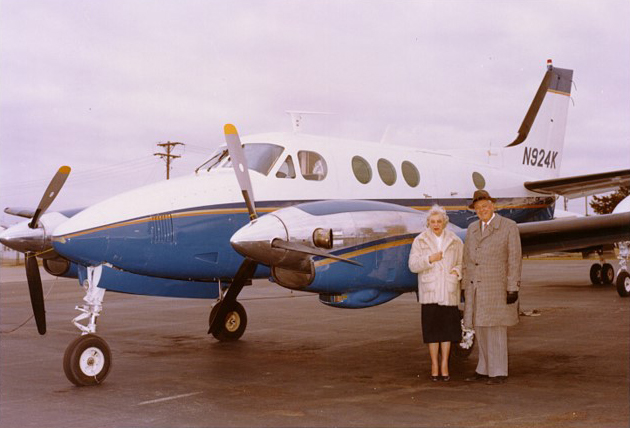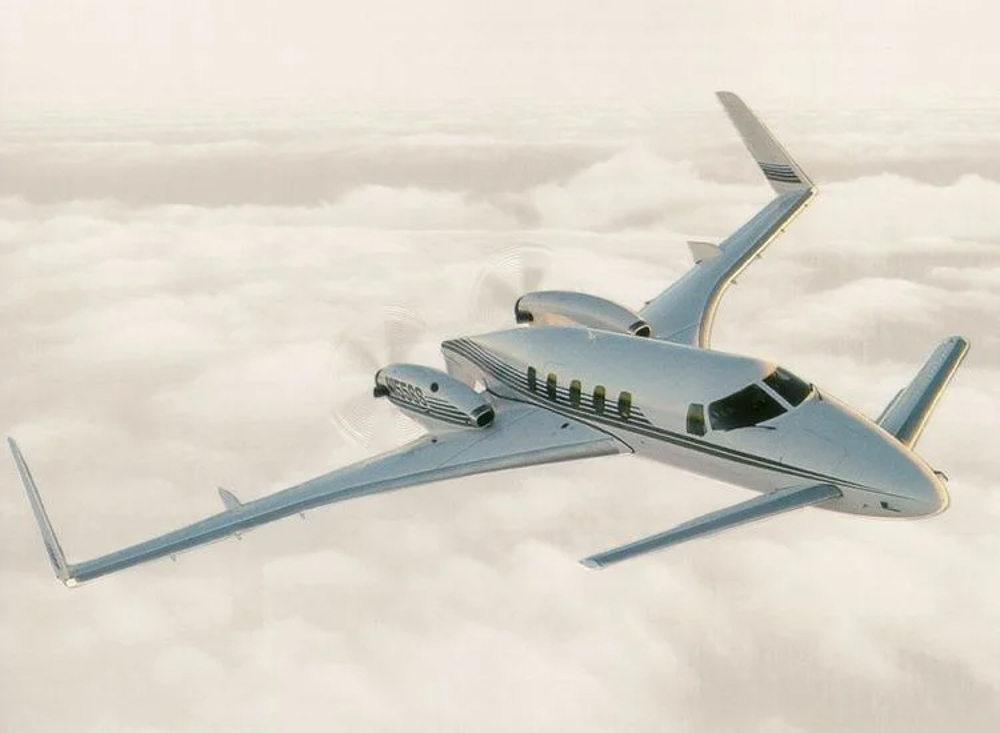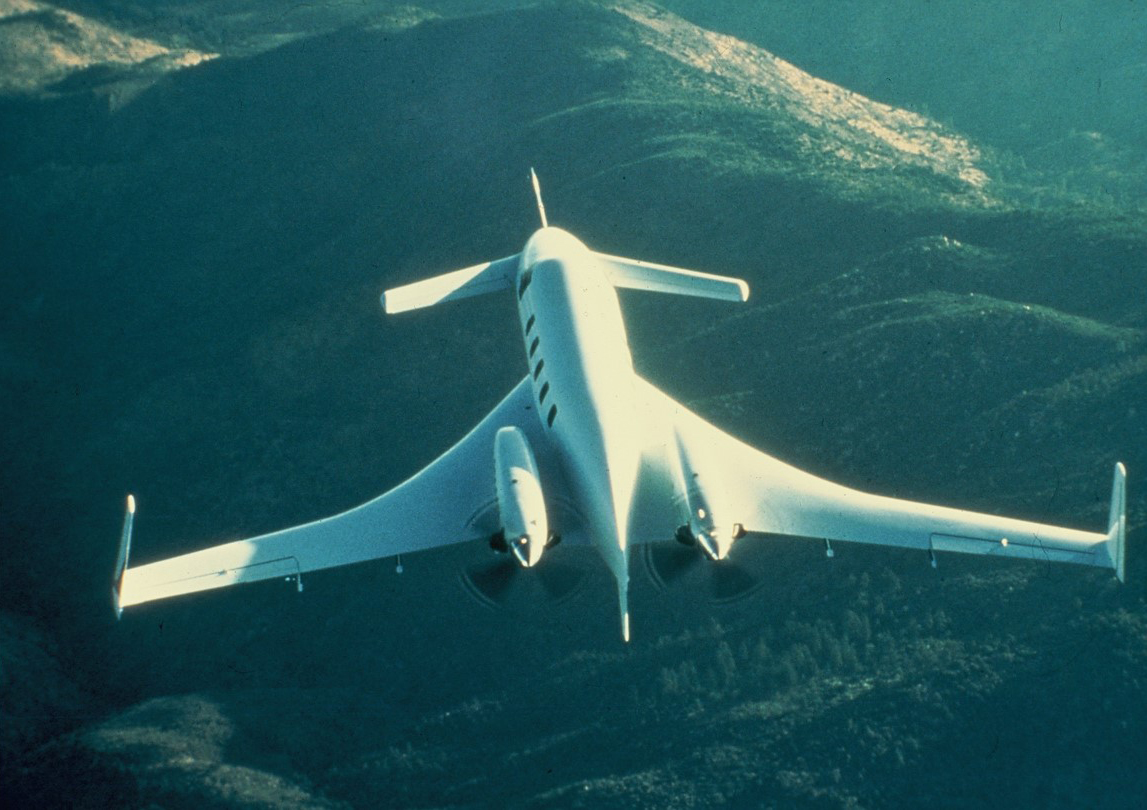When certificated in 1988, Beech Aircraft Corporation’s futuristic Model 2000 Starship 1 was the most rigorously-tested airplane in general aviation history, but it proved a costly misstep and soon faded into obscurity.
Aviation history is replete with failures. Perhaps among the more memorable are the diminutive but abortive “Foxjet,” the gigantic “Spruce Goose” and the innovative “Learfan” to name only a few. For the Beech Aircraft Corporation, a company known worldwide for its great successes, the Model 2000 “Starship 1” stumbled and fell with a resounding crash. Such a calamity was highly uncharacteristic of the company that bore Walter H. Beech’s name. In concert with engineer Theodore “Ted” Wells, in 1932 Beech had begun building a legacy of success with the Model 17R1, an airplane that stunned the aviation world with its maximum speed of 200 mph, unconventional negative stagger-wing configuration and Cadillac-like cabin comfort. From propeller to rudder, the first Beechcraft boldly proclaimed that it was a one-of-a-kind flying machine, a trend-setter that set the pace for the competition to follow.
That mantra was further reinforced in 1945 when the revolutionary V-tail Beechcraft Model 35 “Bonanza” first flew, offering the private pilot and businessman an all-metal, four-place airplane capable of 180 mph and packed with plenty of value for only $7,975. The company’s reputation received another gold star in 1964 when with introduction of the Model 90 King Air – a milestone design that was destined to evolve into a family of airplanes that would dominate the twin-engine turboprop market for decades to come.

As part of that evolutionary process, by the late 1970s the King Air product line had expanded from the Model 90 series to the Model 100 and Model 200 Super King Air with the latter gradually emerging as the benchmark for cabin-class, turboprop-powered business airplanes. Although in terms of overall value for the dollar the King Air series were hard to beat, Beech Aircraft Corporation (BAC) could not afford to sit on its laurels. During the 1970s and early 1980s competition in the twin-turboprop, cabin class was heating up and posed a potential challenge to the King Air’s place of prominence. For example, Cessna was building the Conquest, Swearingen offered the Merlin, Mitsubishi (manufacturer of the famous A6M Reisen “Zero” fighter of World War II) was making market inroads with its fast MU-2, and Aero Commander was achieving market success with its popular Turbo Commander.

In an attempt to create yet another benchmark airplane aimed at providing customers with a replacement for the venerable King Air, in 1979 BAC management made the decision to pursue the design of a new twin-engine business transport. A series of aggressive studies ensued that generated various proposals ranging from conventional to advanced airframe layouts, featuring not only tractor and pusher powerplant installations but also tractor/pusher designs (similar to that used by Cessna Aircraft Company for its 1960s-era Skymaster).
These studies were tightly controlled within the company. Progress toward selection of a viable design continued unabated until the merger in 1980 of BAC with New England-based defense contractor Raytheon. At the helm of Raytheon at that time was Chairman and CEO Thomas L. Phillips and President D. Brainerd Holmes. Raytheon was a vastly different entity than BAC. Both companies had their own distinct corporate culture and ways of doing business that worked well, but eventually would lead to conflict when the two combined. As author Dennis Farney writes in his book, “The Barnstormer and the Lady,” that deftly traces the history of Walter and Olive Ann Beech, “Phillips and Holmes had purchased Beech as part of a grand strategy of diversifying into consumer products.”1
By 1982 that strategy, however, did not include O.A. Beech, Frank E. Hedrick and Edward Burns, all of whom had served many years in senior and top management positions within the company. The trio was suddenly and unexpectedly forced out by Raytheon on May 14 to make way for new management under the leadership of Linden S. Blue, who assumed the presidency. Holmes took Olive Ann’s seat as chairman and CEO.
Farney wrote, “And so, fifty years after Walter and Olive Ann Beech founded Beech [Aircraft Corporation], the Raytheon era began. The era would ultimately end badly but it began with a strategic decision by Raytheon to take an exciting new gamble. Raytheon was going to build a radically new kind of airplane – an elegant, edge-of-technology plane that would jump right over Beech’s competition in a single bound.”2 As Raytheon officials would later learn, the brutal realities of developing a totally new airframe have their own unique way of humbling even the greatest of corporate ambitions.
The proposed airplane at the center of this grand endeavor would be christened Starship 1. Although it would be as elegant as it was radical, Starship 1 would prove incapable of “jumping right over” the competition. Perhaps Farney summed up the situation best: “Few Beech projects would begin with more anticipation, or fail more dismally, than the rakish Starship.”3

Amidst all of the shuffling of management and boardroom drama, Beech and Raytheon officials continued to review potential candidates for Starship 1. Eventually one particular design stood out from the others. Its central design feature was a tandem-wing configuration with twin Pratt & Whitney Canada PT6A-67 turboprop engines mounted as pushers on the aft section of the wing (the first prototype airplane, serial number NC-1, would be powered by PT6A-65A-4 engines until the upgraded -67 version became available). Each engine was rated at 1,200 shp. The position of the powerplants would minimize cabin noise, while seven foot-high appendages on the wings called “tipsails” would provide yaw control similar to that of a conventional rudder. In addition, a small ventral stabilizer mounted below the aft fuselage would further aid directional stability around the yaw axis. The graceful wing, which incorporated integral fuel tanks holding up to 534 gallons, featured a dihedral of slightly more than one degree with two degrees incidence at the root and 24 degrees of sweepback.
Another key goal was to incorporate a cabin larger than that of the Model B200 Super King Air, and the new airplane would feature an interior comparable in volume to that of a mid-size business jet. Last but not least, the bold decision was made to fabricate as much of the airframe as possible of Nomex honeycomb and graphite epoxy composite materials–the use of aluminum alloy would be held to a minimum. Although the use of composite materials in the aerospace industry was still embryonic at that time and typically limited to secondary structures such as fairings, landing gear doors and access panels, composites held the promise of a more favorable strength-to-weight ratio than was attainable using conventional aluminum alloys.
In addition to the talented engineers and designers within Beech Aircraft Corporation itself who were assigned to the Starship 1 project, the company reached out to the one man who was recognized as an expert in composite, tandem-wing airframe design. His name was Burt Rutan and he operated a leading-edge company called Scaled Composites, Inc., located in Mojave, California. Rutan was well known and highly respected in aviation circles, particularly within the experimental, amateur-built segment, for championing the tandem-wing, forward-lifting-surface concept. Working quietly behind the scenes, Beechcraft officials sought Rutan’s help in exploring the aerodynamic design and handling qualities of the production Starship 1.
What eventually emerged from the combined efforts of Beechcraft engineers and Burt Rutan was an airplane that looked as though it would live up to its futuristic name. Externally, its most salient feature was the tandem wing configuration that included a canard lifting surface. Both the main wing and the variable-geometry canard, mounted forward of the cockpit, generated lift. The canard incorporated elevators for pitch control that worked in concert with elevons mounted on the main wing trailing edge.
The canard’s automatic variable sweep system compensated for a shift in the center of lift when the wing’s Fowler-type flaps were extended or retracted. With flaps extended the canard was swept four degrees forward and swept aft 30 degrees with flaps retracted. In an attempt to evaluate the Starship’s fundamental layout, Rutan and his Scaled Composites workshop were engaged to build an 85% scale version of the production airplane. Its chief purpose was to serve as an airborne testbed aimed at probing the Starship 1’s basic aerodynamic and handling qualities. The program was expected to require about 100 hours of flying but it actually flew nearly 500 hours before that task was successfully completed.
Known as the Proof-of-Concept (POC) airframe, the sub-scale airplane flew for the first time on August 29, 1983. Essentially, it was little more than a large flying wind tunnel model. The POC shared only its external appearance with the full-sale airplanes yet to be built. It was never intended to represent a design that could be certified by the Federal Aviation Administration (FAA). Max E. Bleck, who served as president and CEO of Beech Aircraft Corporation in the late 1980s, summed up the POC this way: “The Proof-of-Concept had no certifiable systems and no pressurization. It did not have any of the airframe structure that would be built into Starship 1 and it was not even built out of the same materials.”4
When Beech officials introduced the Starship 1 to the world at the National Business Aircraft Assn. (NBAA) convention in 1983, the POC gave the impression that Beech Aircraft’s next-generation business airplane was well along in development and not far from certification and entry into service. Officials boldly proclaimed that FAA certification was tentatively scheduled for 1985—a mere two years away. As Bleck later lamented, “Sadly, this was not the case.” In fact, BAC did have a plan in place to build the Starship that would meet that ambitious schedule, but the company “had virtually no experience with the materials or the manufacturing techniques required to build it.”5
When the hype of the NBAA announcement had faded into history, monumental obstacles began to appear that would seriously cripple and delay the overall development program schedule. By 1984 it became apparent that many of the subcontractors, who’s ability to deliver components and assemblies on time and on budget was absolutely crucial to the program’s success, would not be able to keep pace with the schedule. As a result, the program was restructured and put on a more realistic timeline, and Raytheon and BAC officials decided to bring the manufacturing phase of the program in-house. Plans called for the construction of six pre-production prototypes, of which three would become flying platforms for FAA certification and the other three would serve as static and damage-tolerance test articles. In addition, these non-flying airframes would help engineers evaluate the effects of extreme temperature and humidity conditions on the Starship’s structure—a step that was critical to achieving FAA approval.
“If there was going to be a Starship 1, Beech Aircraft would have to develop the technical skill to build it by itself,” Bleck wrote.6 In the wake of that decision, the company announced that certification had been reset for the end of 1986. Unfortunately, another setback occurred that year when Raytheon and BAC decided to revise Starship 1’s airframe structure to take advantage of a change made to the Federal Aviation Administration Part 23 regulations. Under the new rule the Starship would be certified at a maximum takeoff weight of 14,000 pounds instead of 12,500 pounds. The regulation, however, required BAC to meet more comprehensive fatigue testing of critical airframe structures, increased fire containment for engine cowlings, emergency exits on both sides of the cabin (if fewer than 15 seats were installed); increased fire-resistant materials for the cabin furnishings, and additional crashworthiness requirements for fuel containment after a minor crash landing.
Looking back 30 years it is important to note that BAC and Raytheon deserve much credit for pioneering the technologies and methodologies required to manufacture a highly sophisticated and technologically advanced airplane of the Model 2000’s size and complexity. Composite materials were still relatively new, particularly within the general aviation industry, and developing a materials data base for the Model 2000 was a massive undertaking. This was a crucial element of the overall program because at that time the FAA had not certified an all-composite, tandem-wing airframe. The significant challenges that lay ahead to certify Starship 1 would have to be overcome one at a time, and would eventually result in a steep (and expensive) learning curve for both BAC and the FAA.
Although Beechcrafters were intimately familiar with metal bonding techniques that had been used in the 1950s to build flight control surfaces for the Convair F-106 fighter interceptor, the composite materials and resins of the 1980s were entirely new and challenging technologies. A hand-picked group of skilled workers underwent extensive training in the many facets of handling composite materials and the resins that bonded them together. During 1984 new tooling had been designed and built and by 1985 the process of manufacturing airframes of the first prototypes was underway. To house manufacturing and production of the Model 2000, Raytheon not only added 242,000 square-feet of new space but also installed an autoclave measuring 60 feet in length by 25 feet in width. The autoclave, ranked as one of the largest in the United States at that time, would greatly expedite production of the fuselage and wings that had to be carefully cured according to rigid specifications to ensure strength and durability.
As Starship 1’s design continued to evolve, engineers conducted thousands of hours of load analysis on the primary and secondary airframe structures. These analyses, which applied time-honored techniques to the new tandem wing design, were essential to validating the airplane’s structural integrity to the FAA. Beech engineers were able to prove conclusively that Starship 1’s airframe was more than capable of handling the anticipated aerodynamic loads. In addition, many hours of wind tunnels tests helped to establish airflow characteristics of the tandem wing configuration, and these results were later verified by flight tests.
As the Model 2000 program advanced, engineering conducted more than 128 static load conditions on three of the test airframes under varying conditions of temperature and humidity as well as damage tolerance. Because the FAA lacked any design-life criteria for composite airframe structures, BAC had to prove that the materials data base developed by the company was viable. Starship 1’s various primary and secondary assemblies were tested to an airframe lifetime of 20,000 hours with a pause every 5,000 hours to inspect for damage. Next, damage was intentionally inflicted and another 20,000 hours of static testing imposed on the structures. In the end the airframe clearly demonstrated to the FAA that it could carry limit load despite the inflicted damage.

Amidst all of the intense engineering and structural certification work, the first prototype airplane, serial number NC-1, was completed and made its first flight on February 15, 1986. Veteran company test pilot “Bud” Francis and flight test engineer Tom Carr manned the cockpit for the historic event. The next month Francis and Carr publicly demonstrated the Starship’s maneuverability before a crowd of about 5,000 people including Beechcrafters, government officials and the media. When flight tests began for FAA certification, NC-1 was assigned to complete stability and control testing. A second prototype flew on June 14 with Lou Johansen and Thomas Schaffstall on the flight deck. It served as a flying testbed for the Starship’s 3,000-psi hydraulic landing gear system, multi-bus electrical grid and the automatic pressurization and environmental systems. Seven months after NC-2’s maiden flight the preproduction Starship 1 (NC-3) took to the Kansas sky on January 5, 1987, under the command of Carr and Tony Marlow. It was the first Starship designed for a maximum takeoff weight of more than 12,500 pounds. The initial type-certificated production airplane (NC-4) flew on April 25, 1989.
As manufacture of the Model 2000 began, quality control was placed at the top of the priority list. BAC assured the integrity of the airframe by meticulous testing featuring sound waves passing through water to detect flaws (such as delamination of composite plies) and to check material density. In addition, crashworthiness and the safety of occupants was becoming an increasingly important factor in airplane design, and Starship 1 was no exception. An important part of the certification process included drop-testing fuselages and inspecting for damage. A final drop test was conducted at 17 feet per second and no damage was recorded.
Another important requirement centered on protection of airframe and engine systems from damaging lighting strikes. Unlike conventional aluminum alloy airframes, composite structures that are left unprotected can explode with significant force. The reason lies in the inherent resistance to current flow of graphite-epoxy and Nomex materials, which is about 1,000 times greater than aluminum alloy. When lightning strikes an unprotected composite airframe it cannot find a current path to an exit point as it can with all-metal airframes. As a result, the high resistance of the materials cause a sudden, rapid rise in temperature that can easily damage composites.
Beechcraft engineers solved the problem by inserting a weave of fine wires in the first layer of composites. The wire mesh acted as a conductor and, when combined with a ground-plane system designed to protect the avionics, provided a current path for lightning to exit the airframe with little or no external cosmetic damage. The airplane’s maintenance manuals set forth specific guidelines on determining the extent of lightning damage. It also stipulated strict procedures that would result in an acceptable repair.
The effectiveness of the Starship 1’s lightning protection defense was vividly demonstrated when NC-2 suffered a strike during final FAA certification flights. Fortunately, the event was recorded on film. As Max Bleck recalled later, “The lightning attached itself to a test pod mounted on the aircraft, striking the front of the pod and exiting from the Starship’s tip sail and rudder. The aircraft was unscathed.”7
In addition to guarding the Starship’s airframe electrical systems, the lightning protection system was essential to preserving operation of the airplane’s Pro Line 4 avionics suite developed by Collins. Highly advanced for the time, the flight and navigation instrumentation was both stunning and somewhat intimidating for pilots accustomed to flying for years with “round gauges.” The new installation featured no less than 14 cathode ray tube (CRT) displays collectively designated the Electronic Flight Information System, or EFIS. It was among the earliest avionics that would later become known almost universally as the “glass cockpit.” A dual installation of Primary Flight Displays (PFD) depicted the airplane’s attitude as well as flight director commands, lateral deviation, glide slope, radio altitude and marker beacon information to the pilot and copilot. A secondary but integral part of the overall EFIS was the Engine Indication and Crew Alerting System (EICAS) that displayed engine instrumentation on a separate group of CRT screens.
After more than five years of development the Starship 1 received FAA provisional certification in June 1988, but certification for two-crew operations was not granted until December 1989. Single-pilot certification by the FAA followed in May 1990 and required a fully-functioning autopilot and flight management system.
Priced at a steep $3.6 million, sales of the Model 2000 were sluggish at best. Although history will remember the Starship 1 as a colossal failure, it was also an outstanding design that not only showcased the expertise of Beech Aircraft Corporation’s engineering and manufacturing capabilities, but reinforced its legacy of innovation and pioneering technical spirit.
Unfortunately, the staggering cost of bringing the airplane to market proved to be its Achilles heel. As Dennis Farney writes in his book, “Instead of the $250 million mentioned in the Wall Street Journal article, the project was well on its way to costing Raytheon an estimated $750 million to $1 billion or more.” He added that the FAA, “having never dealt with a composite fuselage in a civil aviation airplane, demanded that Beech reinforce it with more metal. The Starship already had a relatively short range; the added weight shortened it further.” In the final analysis, it “really wasn’t much better than the tried-and-true Beechcraft King Air…and was slower than a Cessna “Citation,” the “Learjet 31” (both entry-level business jets) and the [turboprop-powered] Piper “Cheyenne,”” according to Farney.8

In its original production configuration the Model 2000 achieved a maximum speed of 352 kt. and had a useful load of 5,286 pounds. Zero fuel weight was 11,800 pounds and rate of climb (two-engine) exceeded 3,000 feet per minute. With sales at a standstill, in 1991 beginning with NC-21, BAC introduced the improved Model 2000A featuring only six seats in the cabin instead of eight. Maximum takeoff weight increased by 400 pounds and fuel capacity rose by 220 pounds. These changes provided an increase in maximum range to 1,552 nautical miles while reducing takeoff field length (at sea level) to 3,854 feet from the Model 2000’s 4,093 feet. The pressurization system’s maximum differential of 8.4 pounds per square inch (psid) provided occupants with a comfortable cabin altitude of 8,000 feet as the Starship 1 cruised at its maximum certificated altitude of 41,000 feet. FAA certification of the Model 2000A, which was based on the Model 2000’s Type Certificate, was granted in June 1992.
Despite these slight improvements the Model 2000A could not save the Starship 1 program. In 1995 BAC terminated production after completing three pre-production airplanes and another 50 for retail sale. Of these, only 10 or 11 were actually sold or leased to customers. Final production versions of the airplane cost $4.9 million, according to the company.
By 2003 it had become painfully clear to Raytheon Aircraft officials that the company had to stop supporting the Model 2000 and 2000A. “The business decision has been made to cease support of the Starship and take those aircraft under our control out of commission, salvage all useable parts and terminate the program,” a company representative said. At that time about 40 airplanes owned by the company (BAC became RAC in September 1994) were scheduled for destruction. Evergreen Air Center in Marana, Arizona, was responsible for stripping the airplanes of avionics, engines, propellers and landing gear before cutting up the airframe and incinerating each one using special, high-temperature furnaces capable of thoroughly burning the carbon fiber composites.9
In summary, the Beechcraft Starship 1 was a daring attempt to reinvent the business airplane, but it proved too expensive for the performance offered and was rejected by the marketplace in favor of existing turboprop- and jet-powered airplanes.10
Notes:
- Oliver, Mary Lynn and Farney, Dennis; “The Barnstormer and the Lady;” Rockhill Books, Kansas City, MO, 2010; Page 171
- Ibid, Page 177
- Ibid
- Bleck, Max E.; “Starship History;” Page 2
- Ibid
- Ibid
- Ibid
- Oliver, Mary Lynn and Farney, Dennis: “The Barnstormer and the Lady;” Rockhill Books, Kansas City, MO, 2010; Page 179
- As of September 2013, no Starships remained at that facility, according to an official of Evergreen Air Center.
- The FAA’s Aircraft Registry, which applies only to airplanes registered in the United States, did not list any Starships in its listing as of September 2013. By 2010 about 50% of the Starship fleet had been destroyed, but other airframes were donated to museums or subjected to testing of composite structures.

 Back
Back